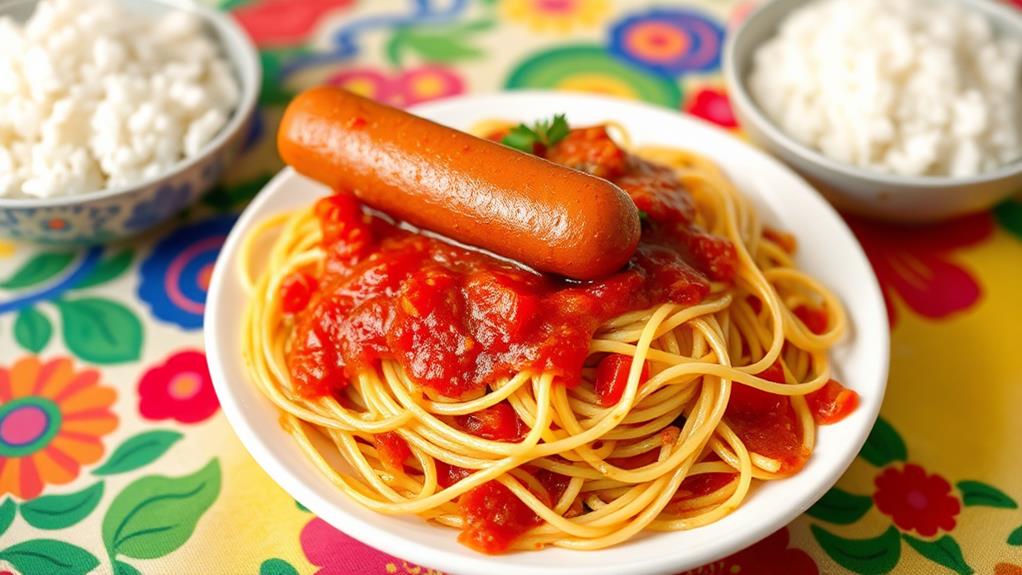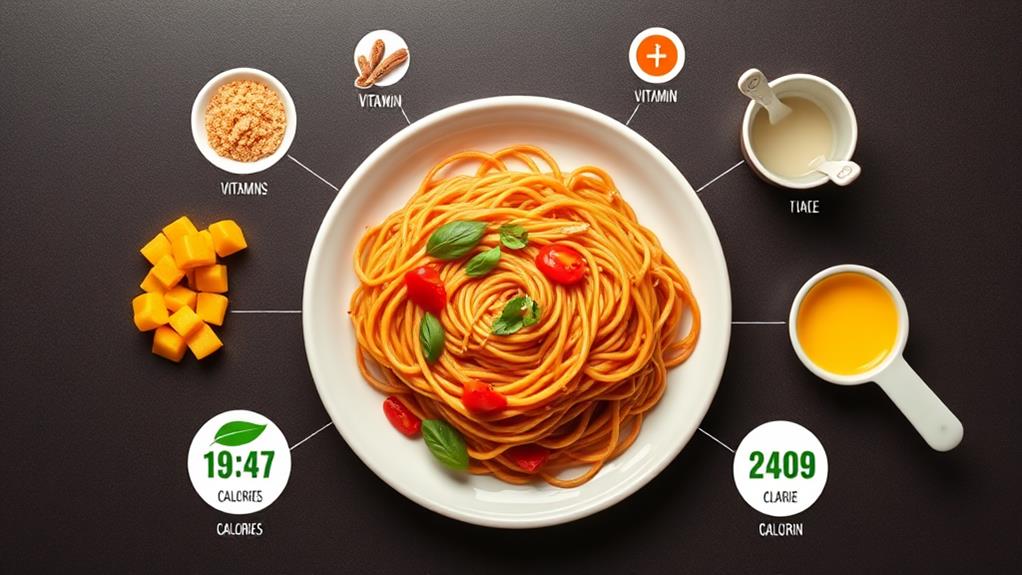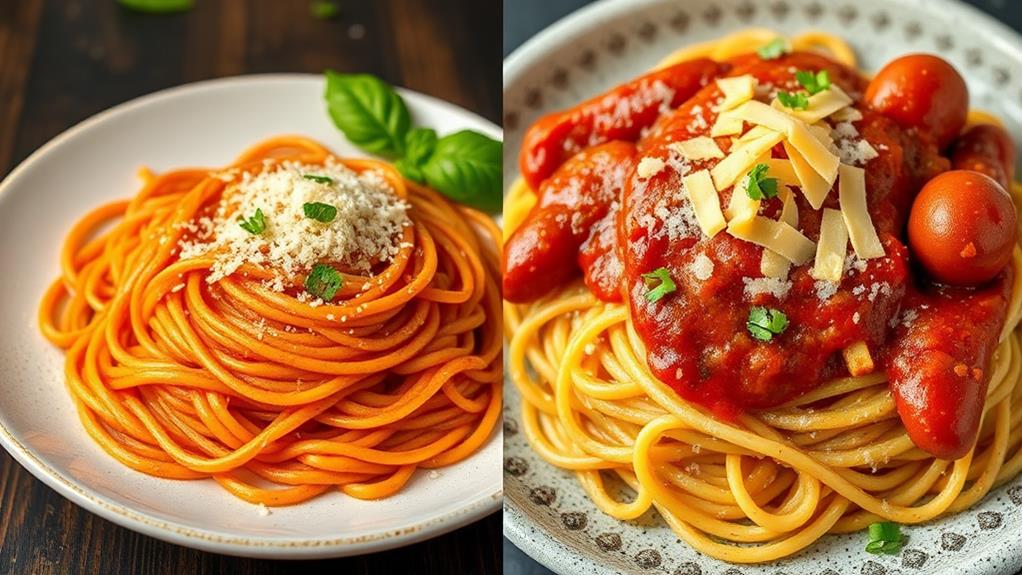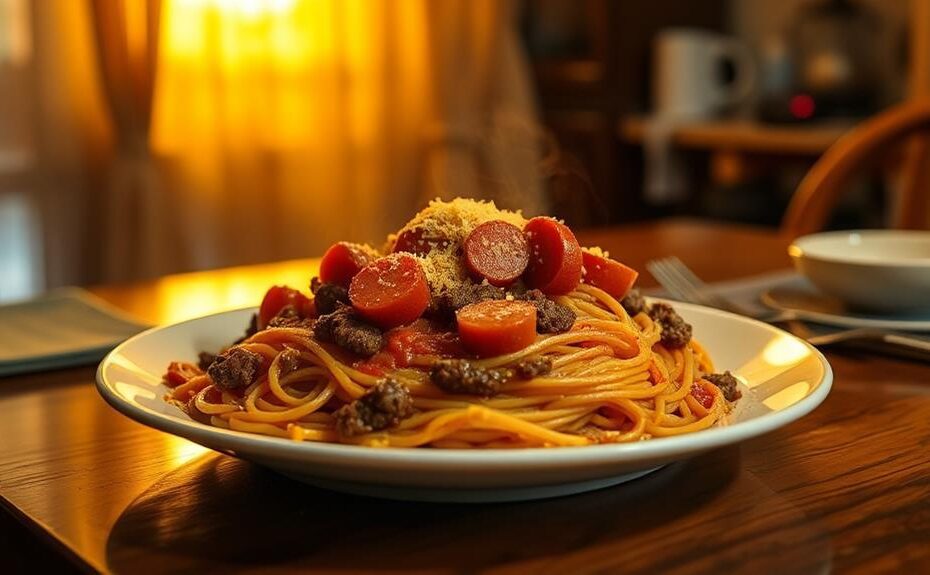Filipino-style spaghetti requires specific ingredients to achieve its unique flavor profile.
Spaghetti noodles are the foundation of the dish. A sweet tomato-based sauce, distinct from regular ketchup, is essential.
Banana ketchup adds a characteristic flavor, while red hot dogs provide a nostalgic touch.
Garlic, onions, and ground beef are also necessary to complete the flavor profile.
These ingredients set Filipino-style spaghetti apart from its Italian counterpart.
Cultural Significance of Filipino Spaghetti

Filipino Spaghetti: A Symbol of Cultural Significance
Filipino spaghetti is more than just a meal; it's a cultural symbol that evokes nostalgia and connects people to their Filipino roots.
The sweet tomato sauce, often made with banana ketchup, represents the Filipino palate's preference for sweetness in food, making it distinct from traditional Italian spaghetti.
The Cultural Significance of Red Food
The vibrant red color of Filipino spaghetti is also culturally significant.
In Filipino culture, red foods are associated with deliciousness and often feature in festive occasions. This is why Filipino spaghetti is a staple at celebrations like birthday parties and family gatherings.
Accessibility and Convenience
Filipino spaghetti's popularity is also reflected in its availability as accessible street food, often sold in plastic bags.
This highlights the importance of convenience in Filipino culinary culture, where food should be easy to consume and on-the-go.
Filipino Spaghetti: A Unifying Force
Whether it's a birthday party or a family gathering, Filipino spaghetti is always at the center of the celebration, bringing people together with its sweet and sticky goodness.
Key Ingredients and Variations
Key Ingredients of Filipino Spaghetti
Filipino spaghetti's unique flavor profile is attributed to its primary ingredients. Spaghetti noodles, sweet tomato-based sauce, banana ketchup, and red hot dogs are essential components that can't be replicated without.
Ground pork or beef is commonly used as the meat base, often enhanced with additional proteins like luncheon meat or Spam for added richness and texture.
Classic Filipino Spaghetti Ingredients and Variations
Spaghetti noodles are a staple in Filipino spaghetti.
Sweet tomato-based sauce is another crucial element, which can be adjusted for sweetness to individual taste.
Banana ketchup adds a distinct flavor, while red hot dogs provide a nostalgic touch.
To enhance the dish, ground beef or pork is used as the meat base.
Variations and Add-ons
Several variations can be made to the classic recipe.
Cheddar cheese or processed cheese can be added on top for extra flavor.
Sugar can be used to increase the sweetness of the sauce.
Chicken powder or bouillon cubes can be added for extra flavor.
Luncheon meat or Spam can be used for added richness, and quick-melt cheese can be used for creaminess.
Cooking Techniques and Tips

Mastering Filipino Spaghetti: Key Techniques and Ingredients
Cooking Spaghetti Noodles
To prepare Filipino spaghetti, start by cooking spaghetti noodles according to package instructions. Avoid overcooking, as al dente texture is essential.
Building the Sauce
Heat oil in a large saucepan over medium heat. Sauté minced garlic and onions until translucent, as this step lays the foundation for the sauce.
Next, add ground beef and cook until browned, breaking it into small pieces as it cooks. Combine the following ingredients: spaghetti sauce, banana ketchup, and a pinch of sugar to taste. Stir to combine, then season with salt to bring out the flavors.
Finally, add evaporated milk towards the end of cooking to achieve a rich, creamy texture.
Essential Equipment for Preparation
Essential Equipment for Preparing Filipino Spaghetti
To prepare Filipino spaghetti, specific equipment is necessary to ensure the dish turns out correctly.
Large Pot
A large pot is required to boil noodles according to package instructions. This is crucial, as undercooked or overcooked noodles can ruin the dish.
Large Skillet
A large skillet is necessary for sautéing aromatics like garlic and onion, browning ground pork, and combining it with tomato sauce.
Measuring Cups and Spoons
Accurate measurements are vital, and measuring cups and spoons are essential for portioning out ingredients like sugar and seasonings.
Pasta Server or Tongs
A pasta server or tongs are necessary for serving perfectly coated noodles.
Grater
A grater is required for shredding cheese, a crucial topping for Filipino spaghetti.
Nutrition Information and Serving Suggestions

Nutrition Information
A typical serving of Filipino spaghetti contains approximately 529 calories, with 63g of carbohydrates, 23g of protein, and 19g of fat, making it a hearty meal option.
Serving Suggestions
To enhance the flavor and creaminess of Filipino spaghetti, top it with shredded quick melt cheese.
For a balanced meal, pair it with fried chicken and garlic bread, perfect for gatherings and celebrations.
Adjust the ingredients according to dietary preferences to cater to varying tastes.
Filipino spaghetti is also a convenient meal option, as leftovers can be refrigerated for up to three days or frozen for up to two months.
Common Questions and Community Reactions
Filipino spaghetti is a beloved dish that sparks debate and nostalgia among Filipino food enthusiasts.
The use of beef hot dogs instead of traditional pork hot dogs is a common variation, with some considering it a welcome adaptation and others viewing it as sacrilegious.
Banana ketchup is a popular condiment in Filipino spaghetti, with some considering it a must-have and others seeing it as a sweet substitute for regular ketchup.
Filipino spaghetti holds cultural significance, with many remembering it as a staple at birthday parties and family gatherings.
Magic Sarap seasoning is a common ingredient, with some swearing by it as a traditional element and others dismissing it as non-authentic.
Despite differences in opinion, the Filipino food community comes together to celebrate the unique flavors of Filipino spaghetti and its variations.
Sharing cooking experiences on social media can connect you with a supportive community that's eager to discuss and appreciate your creations.
What are the Key Ingredients in Traditional Filipino Style Spaghetti?
The key ingredients that define filipino pasta, such as traditional Filipino style spaghetti, include banana ketchup, hotdogs, and ground pork. These unique flavors and elements set it apart from other pasta dishes and create a sweet and savory flavor profile that is loved by many Filipinos.
Authenticity and Adaptations in Recipes

Authenticity and Adaptations in Filipino Spaghetti Recipes
Filipino spaghetti is characterized by its adaptability and blurred lines between authenticity and innovation. This means that the concept of a "traditional" or "authentic" recipe is less rigid, and personal variations are encouraged.
Common threads in Filipino spaghetti recipes include:
- Sweetness is a key flavor component, achieved through the use of sweet banana ketchup or regular tomato ketchup with added sugar.
- Protein options are flexible, with Filipino-style red hot dogs being a staple, but ground pork or beef serving as viable substitutes for added flavor.
- Sauce preparation methods vary, with tomato paste and evaporated milk creating a rich, creamy sauce, and store-bought Filipino spaghetti sauce offering a convenient alternative.
- Adaptations can accommodate dietary restrictions, such as excluding hot dogs or adding vegetables like mushrooms.
The strength of Filipino spaghetti lies in its flexibility. This allows individuals to stick to traditional recipes or experiment with new ingredients to create their own unique flavor profiles.
The essence of Filipino spaghetti is about making it your own.
Frequently Asked Questions
What Makes Filipino Spaghetti Different?
Filipino spaghetti is distinct due to its sweet sauce. This sweetness comes from the use of banana ketchup, a common condiment in Filipino cuisine.
The ground meat used in Filipino spaghetti is also unique, as it's seasoned with a blend of Filipino flavors and spices that set it apart from traditional spaghetti dishes.
Filipino spaghetti is often served at family gatherings and celebrations, evoking nostalgic memories for many Filipinos.
The dish is a staple in Filipino culture, and its unique flavor profile has contributed to its popularity.
What Is Jollibee Spaghetti Made Of?
Jollibee Spaghetti is a Filipino twist on traditional spaghetti.
It combines sweet hotdogs, ground meat, and a cheese topping to create a unique flavor profile.
The Jollibee sauce, infused with banana ketchup, is a key component that sets it apart.
This sweet and savory sauce complements the spaghetti noodles, making it a distinctive Filipino dish.
What Are the Materials Used in Spaghetti?
Spaghetti is typically made from wheat flour and water. The type of flour used can vary, resulting in different types of spaghetti, such as whole wheat or gluten-free.
The sauce is a crucial component of spaghetti, and common options include marinara, arrabbiata, and pesto. The choice of sauce can greatly impact the flavor profile of the dish.
Cooking techniques for spaghetti range from boiling to grilling, which can affect the texture and flavor of the noodles. Boiling is the most common method, but grilling can add a smoky flavor to the spaghetti.
It is worth noting that regional differences and nutritional values can vary greatly depending on the type of spaghetti and sauce used.
What Is the Secret to Good Spaghetti?
Good spaghetti requires mastering cooking techniques and balancing flavors. To achieve this, start by sautéing aromatics like onions and garlic to bring out their flavors.
Flavor balance is crucial, so aim for a combination of sweet and tangy tastes.
Using high-quality ingredients is essential. Choose fresh tomatoes and good-quality olive oil for the best results.
Seasoning is also important, so don't be shy with salt and herbs like basil and oregano.
Adding texture can elevate your spaghetti dish. Try adding grated cheese, like Parmesan or mozzarella, to give your spaghetti a creamy element.
